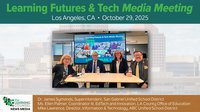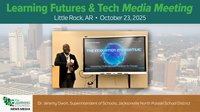As part of our mission to bring more instructional technology into the classroom, we’ve been exploring multimodal literacy experiences for elementary students. The effort is part of a statewide push to find new ways to deliver literacy instruction across all types of media, including right in the school’s media center.
Our ELA standards are changing next year, and one of the things that's really different about them is how kids will be interacting with information across many modes. With this in mind, we’ve been redesigning how we use our media centers to make them more of a hub, and how to include more STEM activities in those hubs.”
For Hutto Elementary School’s new media center, we incorporated many different modern learning tools in an environment where students can learn, collaborate and/or work independently. We partnered with MiEN, PowerUpEDU and Woz ED to create a space that truly exemplifies our district’s overarching goal of supporting students on their multimodal literacy journeys.
Here are five steps we took to ensure that our new media center stayed on budget, met our students’ needs and helped us achieve our larger goal of extending literacy instruction across multiple different modes:
- Start by getting the flow first. Right out of the gate, we began looking at ways to create spaces where resources could be shared, and where students could take ownership of the actual learning. Makerspaces fit the bill perfectly because they help infuse accountability into the hands-on learning experience. We also looked for the right equipment and curriculum for the new media center and worked with the three outside providers to create a common space where everything “flowed properly,” and where students were encouraged to collaborate and work together despite the largely one-on-one nature of digital tools.
- Find new ways to showcase student work. We put some thought into how traditional wall posters or bulletin boards—both of which have always been used to showcase exemplary work—could be transferred into the digital environment. PowerUpEDU provided guidance for the school’s new active floor and AR/VR equipment. We were very deliberate in creating ways to display the digital work of students in all of our designs, and really thought about how to systematically achieve that. We didn’t want to complicate the management aspect of those displays, knowing that it takes a bit more work to put something up digitally than it does to just staple it to the wall.
- Make it moveable. Within the new space, we knew that we wanted specific “zones” for certain activities, but the walls between those zones could be blurred based on the type of learning happening in those areas. We came up with a very modular, adaptable furniture, fixture and storage approach that would fit the bill perfectly. Installing moveable storage fixtures, for example, would support quick room reconfigurations and avoid big clunky storage cabinets that are pinned to the wall. We didn’t want moving the cabinets into another room to be a cumbersome. For students who want to read aloud or to themselves, we also included a small space filled with counter-height tables, soft seating and a canopy. It’s been a huge hit with the students who come there to enjoy a book.
- Find partners that can stick to your budget. We had a very specific budget for this project, but we also wanted the outcome to look as cool as possible. We appreciate our furniture partner’s willingness to come and work within that budget. The question was, how could we put lipstick on the rest of this pig to make the biggest impact? I trusted our design partner to help answer that question by selecting the perfect wall color, for example. That was really helpful, and it made the space sing.
- Let your imagination run wild. The space itself is a giant, square room (which was previously a cafeteria) with two classrooms off the back and a lot of glass. One side is a makerspace zone that’s separated from the fiction section of the library with mobile carts. For seating, we selected wobbly stools, regular chairs and soft seating, all of which are easy to use and change around to meet the current need. That modularity really paid off about two weeks ago when we had 120 students rotating in four groups throughout the media center. We cleared the entire space out, moved everything around the edges and set it up as a giant corn maze where students were coding robots.
Creating Modern, Adaptable Learning Environments
Our district has spent the last few years creating makerspaces where students can go to “produce” things across various different modes. And while literacy remains a core focus for the district—and the state of Georgia as a whole—We have a makerspace in every school now.
We’re always looking at how to best flow kids through those spaces and how to make that work with the other initiatives. That’s where our vendor partners have really been helping us reimagine our spaces and transform them into very modern, adaptable learning environments.
About the author
Amy Zock is the director of instructional technology and digital learning at Decatur County Schools in Decatur, GA.











